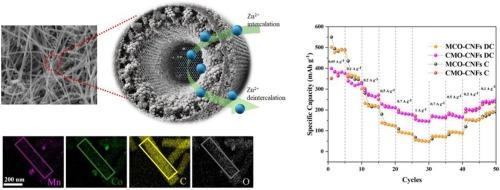Tailoring the Mn/Co ratio in electrospun Mn-Co oxide embedded-carbon nanofibers as cathode for high-performance zinc-ion batteries
Q1 Materials Science
引用次数: 0
Abstract
Manganese- and cobalt-based materials are considered promising cathode candidates for zinc-ion batteries (ZIBs) due to their environmental sustainability, high specific capacities, and the natural abundance of their constituent elements compared to those used in other metal-ion battery technologies. Nonetheless, their extensive utilization is impeded by sluggish kinetics and suboptimal durability. In addressing these challenges through nanostructure engineering, we present a novel approach by tailoring the Mn/Co ratio to synthesize MnCo2O4 (MCO) and CoMn2O4 (CMO) entrapped carbon nanofibers (CNFs) via the electrospinning technique and post-treatment. MCO-CNFs and CMO-CNFs exhibit excellent performance as zinc cathodes in ZIBs, achieving initial specific capacities of 501.94 mAh g−1 and 399.32 mAh g−1 at 0.05 A g−1, respectively. CMO-CNFs demonstrate superior rate performance at high current densities, whereas MCO-CNFs exhibit better cycle stability. This complementary behavior highlights the tunable electrochemical characteristics enabled by Mn/Co ratio adjustment. Insightfully, the influence of the Mn/Co ratio on the electronic state of the elements and the electrochemical storage behavior of ZIBs during the charge/discharge process is convincingly explored using ex-situ techniques such as scanning electron microscopy and operando X-ray absorption near-edge structure, proving that MCO-CNFs are more stable and redox-reversible than CMO-CNFs.

电纺丝Mn-Co氧化物嵌入碳纳米纤维作为高性能锌离子电池阴极的Mn/Co比调整
与其他金属离子电池技术相比,锰基和钴基材料由于其环境可持续性、高比容量以及其组成元素的天然丰度而被认为是锌离子电池(zib)极有前途的阴极候选者。然而,它们的广泛利用受到缓慢的动力学和次优耐久性的阻碍。为了解决这些挑战,我们提出了一种新的方法,通过静电纺丝技术和后处理,通过调整Mn/Co比来合成MnCo2O4 (MCO)和CoMn2O4 (CMO)包裹的碳纳米纤维(CNFs)。MCO-CNFs和CMO-CNFs在zbs中表现出优异的锌阴极性能,在0.05 A g−1下分别达到501.94 mAh g−1和399.32 mAh g−1。CMO-CNFs在高电流密度下表现出优越的速率性能,而MCO-CNFs表现出更好的循环稳定性。这种互补行为突出了Mn/Co比例调节所实现的可调谐电化学特性。利用扫描电镜和operando x射线吸收近边结构等非原位技术,深入研究了Mn/Co比对元素电子态和zbs在充放电过程中的电化学存储行为的影响,证明了MCO-CNFs比cmos - cnfs更稳定、更氧化还原可逆。
本文章由计算机程序翻译,如有差异,请以英文原文为准。
求助全文
约1分钟内获得全文
求助全文
来源期刊

Materials Science for Energy Technologies
Materials Science-Materials Science (miscellaneous)
CiteScore
16.50
自引率
0.00%
发文量
41
审稿时长
39 days
 求助内容:
求助内容: 应助结果提醒方式:
应助结果提醒方式:


